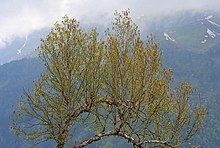Betula utilis
| Betula utilis | |
|---|---|
 |
|
| Scientific classification | |
| Kingdom: | Plantae |
| (unranked): | Angiosperms |
| (unranked): | Eudicots |
| (unranked): | Rosids |
| Order: | Fagales |
| Family: | Betulaceae |
| Genus: | Betula |
| Subgenus: | Betula |
| Species: | B. utilis |
| Binomial name | |
|
Betula utilis D.Don |
|
| Synonyms | |
|
B. bhojpatra Wall. |
|
B. bhojpatra Wall.
Betula utilis (Himalayan birch, bhojpatra, Sanskrit: भूर्ज bhūrja) is a birch tree native to the Himalayas, growing at elevations up to 4,500 m (14,800 ft). The specific epithet, utilis, refers to the many uses of the different parts of the tree. The white, paper-like bark of the tree was used in ancient times for writing Sanskrit scriptures and texts. It is still used as paper for the writing of sacred mantras, with the bark placed in an amulet and worn for protection. Selected varieties are used for landscaping throughout the world, even while some areas of its native habitat are being lost due to overuse of the tree for firewood.
Betula utilis was described and named by botanist David Don in his Prodromus Florae Nepalensis (1825), from specimens collected by Nathaniel Wallich in Nepal in 1820.Betula jacquemontii (Spach), first described and named in 1841, was later found to be a variety of B. utilis, and is now Betula utilis var. jacquemontii.
In its native habitat, B. utilis tends to form forests, growing as a shrub or tree reaching up to 20 m (66 ft) tall. It frequently grows among scattered conifers, with an undergrowth of shrubs that typically includes evergreen Rhododendron. The tree depends on moisture from snowmelt, rather than from the monsoon rains. They often have very bent growth due to the pressure of the deep winter snow in the Himalaya.
Leaves are ovate, 5 to 10 cm (2.0 to 3.9 in) long, with serrated margins, and slightly hairy. Flowering occurs from May–July, with only a few male catkins, and short, single (sometimes paired) female catkins. The perianth has four parts in male flowers, and is absent in the female flowers. Fruits ripen in September–October.
The thin, papery bark is very shiny, reddish brown, reddish white, or white, with horizontal lenticels. The bark peels off in broad, horizontal belts, making it very usable for creating even large pages for texts. A fungal growth, locally called bhurja-granthi, forms black lumps on the tree weighing up to 1 kg.
...
Wikipedia
